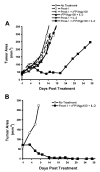Bedside to bench and back again: how animal models are guiding the development of new immunotherapies for cancer
- PMID: 15155774
- PMCID: PMC1484508
- DOI: 10.1189/jlb.0304120
Bedside to bench and back again: how animal models are guiding the development of new immunotherapies for cancer
Abstract
Immunotherapy using adoptive cell transfer is a promising approach that can result in the regression of bulky, invasive cancer in some patients. However, currently available therapies remain less successful than desired. To study the mechanisms of action and possible improvements in cell-transfer therapies, we use a murine model system with analogous components to the treatment of patients. T cell receptor transgenic CD8+ T cells (pmel-1) specifically recognizing the melanocyte differentiation antigen gp100 are adoptively transferred into lympho-depleted mice bearing large, established, 14-day subcutaneous B16 melanoma (0.5-1 cm in diameter) on the day of treatment. Adoptive cell transfer in combination with interleukin interleukin-2 or interleukin-15 cytokine administration and vaccination using an altered form of the target antigen, gp100, can result in the complete and durable regression of large tumor burdens. Complete responders frequently develop autoimmunity with vitiligo at the former tumor site that often spreads to involve the whole coat. These findings have important implications for the design of immunotherapy trials in humans.
Figures





Similar articles
-
Adoptive transfer of vaccine-induced peripheral blood mononuclear cells to patients with metastatic melanoma following lymphodepletion.J Immunol. 2006 Nov 1;177(9):6527-39. doi: 10.4049/jimmunol.177.9.6527. J Immunol. 2006. PMID: 17056585 Free PMC article. Clinical Trial.
-
BRAF inhibition increases tumor infiltration by T cells and enhances the antitumor activity of adoptive immunotherapy in mice.Clin Cancer Res. 2013 Jan 15;19(2):393-403. doi: 10.1158/1078-0432.CCR-12-1626. Epub 2012 Nov 30. Clin Cancer Res. 2013. PMID: 23204132 Free PMC article.
-
Persistence of CTL clones targeting melanocyte differentiation antigens was insufficient to mediate significant melanoma regression in humans.Clin Cancer Res. 2015 Feb 1;21(3):534-43. doi: 10.1158/1078-0432.CCR-14-2208. Epub 2014 Nov 25. Clin Cancer Res. 2015. PMID: 25424856 Free PMC article. Clinical Trial.
-
New cancer therapy by immunomanipulation: development of immunotherapy for human melanoma as a model system.Cornea. 2000 May;19(3 Suppl):S2-6. doi: 10.1097/00003226-200005001-00002. Cornea. 2000. PMID: 10832714 Review.
-
Combination immunotherapies implementing adoptive T-cell transfer for advanced-stage melanoma.Melanoma Res. 2018 Jun;28(3):171-184. doi: 10.1097/CMR.0000000000000436. Melanoma Res. 2018. PMID: 29521881 Free PMC article. Review.
Cited by
-
Design and Evaluation of Synthetic Delivery Formulations for Peptide-Based Cancer Vaccines.BME Front. 2024 Mar 21;5:0038. doi: 10.34133/bmef.0038. eCollection 2024. BME Front. 2024. PMID: 38515636 Free PMC article.
-
Adoptive T-Cell Transfer to Treat Lymphangioleiomyomatosis.Am J Respir Cell Mol Biol. 2020 Jun;62(6):793-804. doi: 10.1165/rcmb.2019-0117OC. Am J Respir Cell Mol Biol. 2020. PMID: 32078336 Free PMC article.
-
Viral-mimicking protein nanoparticle vaccine for eliciting anti-tumor responses.Biomaterials. 2016 Apr;86:83-91. doi: 10.1016/j.biomaterials.2016.01.056. Epub 2016 Feb 1. Biomaterials. 2016. PMID: 26894870 Free PMC article.
-
MHC-class I-restricted CD4 T cells: a nanomolar affinity TCR has improved anti-tumor efficacy in vivo compared to the micromolar wild-type TCR.Cancer Immunol Immunother. 2013 Feb;62(2):359-69. doi: 10.1007/s00262-012-1336-z. Epub 2012 Aug 25. Cancer Immunol Immunother. 2013. PMID: 22926060 Free PMC article.
-
Evidence of systemic Th2-driven chronic inflammation in patients with metastatic melanoma.Clin Cancer Res. 2009 Mar 15;15(6):1931-9. doi: 10.1158/1078-0432.CCR-08-1980. Epub 2009 Feb 24. Clin Cancer Res. 2009. PMID: 19240164 Free PMC article.
References
-
- Jemal A, Tiwari RC, Murray T, Ghafoor A, Samuels A, Ward E, Feuer EJ, Thun MJ. Cancer statistics, 2004. CA Cancer J Clin. 2004;54:8–29. - PubMed
-
- Balch CM, Soong SJ, Gershenwald JE, Thompson JF, Reintgen DS, Cascinelli N, Urist M, McMasters KM, Ross MI, Kirkwood JM, Atkins MB, Thompson JA, Coit DG, Byrd D, Desmond R, Zhang Y, Liu PY, Lyman GH, Morabito A. Prognostic factors analysis of 17,600 melanoma patients: Validation of the American Joint Committee on Cancer melanoma staging system. J Clin Oncol. 2001;19:3622–3634. - PubMed
-
- Kirkwood JM, Strawderman MH, Ernstoff MS, Smith TJ, Borden EC, Blum RH. Interferon-α-2b adjuvant therapy of high risk resected cutaneous melanoma: the Eastern Cooperative Oncology Group trial EST 1684. J Clin Oncol. 1996;14:7–17. - PubMed
-
- Manola J, Atkins M, Ibrahim J, Kirkwood J. Prognostic factors in metastatic melanoma: a pooled analysis of Eastern Cooperative Oncology Group trials. J Clin Oncol. 2000;18:3782–3793. - PubMed
-
- Atkins MB, Lotze MT, Dutcher JP, Fisher RI, Weiss G, Margolin K, Abrams J, Sznol M, Parkinson D, Hawkins M, Paradise C, Kunkel L, Rosenberg SA. High-dose recombinant interleukin-2 therapy for patients with metastatic melanoma: analysis of 270 patients treated between 1985 and 1993. J Clin Oncol. 1999;17:2105–2116. - PubMed
MeSH terms
Grants and funding
LinkOut - more resources
Full Text Sources
Other Literature Sources
Medical
Research Materials

